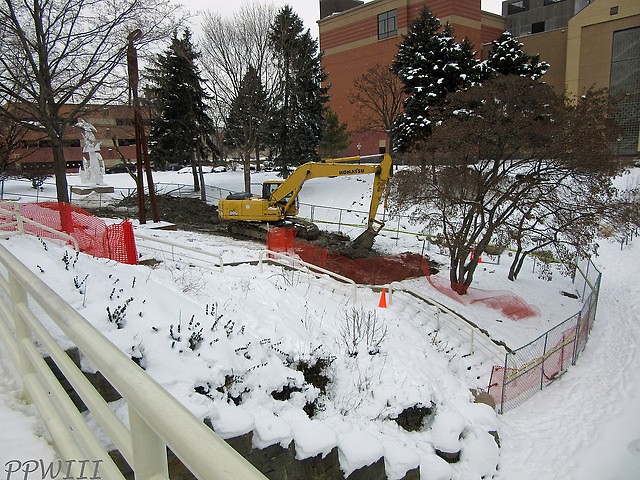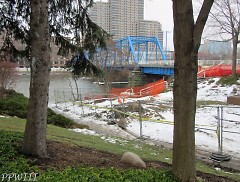At the beginning of January, construction crews were seen working along the westside of the Grand River near the Blue Bridge and the Grand Valley State University Eberhard Center to fill a sinkhole that revealed a century-old gypsum mine located under the west side of Grand Rapids.
The William T. Powers Mine was built in 1898 with work ending around 1909. According to the History of Grand Rapids website, “The original area Powers Mine covered about nine acres extending from the Pearl Street Bridge to the Fulton Street Bridge.”
The tunnels of the mine are one hundred feet beneath the surface and still run underground today.
Gypsum was one of Grand Rapids' earliest important industries. It was gypsum, or plaster, that was discovered in large surface beds along Plaster Creek where it meets the Grand River.
The first gypsum quarry on the westside of the Grand River was that of Richard Butterworth. The deposits there were not on the surface but many feet below layers of clay, limestone, and slate.
By 1850 the first mill for grinding the gypsum was producing 60 tons daily.
Gypsum was first used as a land sweetener for fertilizer by farmers with only minute portions of the mined material used for plaster and stucco. That changed as the population and needs for building materials increased. Gypsum from Grand Rapids was sent around the world.
With the demand high, other mines were open on Grand Rapids westside. Operation for gypsum ceased at the former Domtar mine, the last operating mine in the state of Michigan. It had been bought out by Georgia-Pacific and was closed in 1999.
With no more mine operations, Grand Rapids is left with miles of unused mine tunnels under the city's westside.
Are there other areas of the Westside in danger of sinking? This is the first article in a series exploring what it means to have an extensive network of mines in the same area a lot of new business development is taking place.
The Rapidian, a program of the 501(c)3 nonprofit Community Media Center, relies on the community’s support to help cover the cost of training reporters and publishing content.
We need your help.
If each of our readers and content creators who values this community platform help support its creation and maintenance, The Rapidian can continue to educate and facilitate a conversation around issues for years to come.
Please support The Rapidian and make a contribution today.


